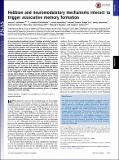| dc.contributor.author | Johansen, Joshua P. | |
| dc.contributor.author | Diaz-Mataix, Lorenzo | |
| dc.contributor.author | Hamanaka, Hiroki | |
| dc.contributor.author | Ozawa, Takaaki | |
| dc.contributor.author | Ycu, Edgar | |
| dc.contributor.author | Koivumaa, Jenny | |
| dc.contributor.author | Hou, Mian | |
| dc.contributor.author | Deisseroth, Karl | |
| dc.contributor.author | LeDoux, Joseph E. | |
| dc.contributor.author | Kumar, Ashwani, S.M. Massachusetts Institute of Technology | |
| dc.contributor.author | Boyden, Edward | |
| dc.date.accessioned | 2015-06-08T18:06:48Z | |
| dc.date.available | 2015-06-08T18:06:48Z | |
| dc.date.issued | 2014-12 | |
| dc.date.submitted | 2014-03 | |
| dc.identifier.issn | 0027-8424 | |
| dc.identifier.issn | 1091-6490 | |
| dc.identifier.uri | http://hdl.handle.net/1721.1/97222 | |
| dc.description.abstract | A long-standing hypothesis termed “Hebbian plasticity” suggests that memories are formed through strengthening of synaptic connections between neurons with correlated activity. In contrast, other theories propose that coactivation of Hebbian and neuromodulatory processes produce the synaptic strengthening that underlies memory formation. Using optogenetics we directly tested whether Hebbian plasticity alone is both necessary and sufficient to produce physiological changes mediating actual memory formation in behaving animals. Our previous work with this method suggested that Hebbian mechanisms are sufficient to produce aversive associative learning under artificial conditions involving strong, iterative training. Here we systematically tested whether Hebbian mechanisms are necessary and sufficient to produce associative learning under more moderate training conditions that are similar to those that occur in daily life. We measured neural plasticity in the lateral amygdala, a brain region important for associative memory storage about danger. Our findings provide evidence that Hebbian mechanisms are necessary to produce neural plasticity in the lateral amygdala and behavioral memory formation. However, under these conditions Hebbian mechanisms alone were not sufficient to produce these physiological and behavioral effects unless neuromodulatory systems were coactivated. These results provide insight into how aversive experiences trigger memories and suggest that combined Hebbian and neuromodulatory processes interact to engage associative aversive learning. | en_US |
| dc.language.iso | en_US | |
| dc.publisher | National Academy of Sciences (U.S.) | en_US |
| dc.relation.isversionof | http://dx.doi.org/10.1073/pnas.1421304111 | en_US |
| dc.rights | Article is made available in accordance with the publisher's policy and may be subject to US copyright law. Please refer to the publisher's site for terms of use. | en_US |
| dc.source | National Academy of Sciences (U.S.) | en_US |
| dc.title | Hebbian and neuromodulatory mechanisms interact to trigger associative memory formation | en_US |
| dc.type | Article | en_US |
| dc.identifier.citation | Johansen, Joshua P., Lorenzo Diaz-Mataix, Hiroki Hamanaka, Takaaki Ozawa, Edgar Ycu, Jenny Koivumaa, Ashwani Kumar, et al. “Hebbian and Neuromodulatory Mechanisms Interact to Trigger Associative Memory Formation.” Proceedings of the National Academy of Sciences 111, no. 51 (December 8, 2014): E5584–E5592. | en_US |
| dc.contributor.department | Massachusetts Institute of Technology. Department of Brain and Cognitive Sciences | en_US |
| dc.contributor.department | McGovern Institute for Brain Research at MIT | en_US |
| dc.contributor.department | Program in Media Arts and Sciences (Massachusetts Institute of Technology) | en_US |
| dc.contributor.mitauthor | Boyden, Edward Stuart | en_US |
| dc.relation.journal | Proceedings of the National Academy of Sciences | en_US |
| dc.eprint.version | Final published version | en_US |
| dc.type.uri | http://purl.org/eprint/type/JournalArticle | en_US |
| eprint.status | http://purl.org/eprint/status/PeerReviewed | en_US |
| dspace.orderedauthors | Johansen, Joshua P.; Diaz-Mataix, Lorenzo; Hamanaka, Hiroki; Ozawa, Takaaki; Ycu, Edgar; Koivumaa, Jenny; Kumar, Ashwani; Hou, Mian; Deisseroth, Karl; Boyden, Edward S.; LeDoux, Joseph E. | en_US |
| dc.identifier.orcid | https://orcid.org/0000-0002-0419-3351 | |
| mit.license | PUBLISHER_POLICY | en_US |
| mit.metadata.status | Complete | |
